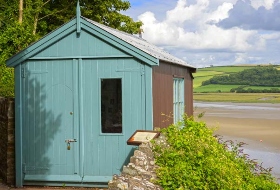When is listed building consent required?
Page updated on: 15/02/2024
Listed Building Consent is required if any changes that you need, or would like to undertake to your listed building, affect the special historic interest or character of that building or its setting. Even changes which might seem inconsequential to you, to an expert might be quite significant. If in doubt please do not hesitate to get in touch with the Built Heritage team before work commences and we would be happy to check whether consent is required.
Before you make an application for Listed Building Consent you may well also benefit from attending the Tywi Centre course ‘Listed Building Consent: a step-by-step guide to making changes to your historic home’.
For properties in Carmarthenshire you can use the interactive map provided on this website:
- Scroll down to the section ‘My nearest- Planning information’.
- Click on the drop-down box ‘Choose an option’.
- Click ‘Listed Buildings’ and enter the postcode of the property that you are enquiring about.
Please note that sometimes a building is listed under a different name, or is in the process of being listed, or part of a property is listed which isn’t linked to the postcode, so you would be advised to contact the Built Heritage team to do a full search.
For details of all listed Assets in Wales and to access a Listing Report for the property you are enquiring about, visit the ‘Cadw Cymru - National Historic Assets of Wales’ section on the Cadw website:
- To access information Click ‘show filters’.
- On the drop down box ‘Asset Type’ select ‘Listed Building’ and you can enter as much detail as possible, then press ‘search’.
- You are given the option of Map view or List View.
- If you click ‘List View’ you can click on ‘Report’ and this will open a ‘Full Report for Listed Buildings’ for your property of interest.
Those without internet access can find out if something is listed by contacting the Carmarthenshire Built Heritage team.
Listing gives protection to the whole building: both the interior (including fixtures) and exterior of the building are protected, regardless of the grade.
Any object or structure fixed to a listed building is also protected and this can include extensions (including modern additions), walls, porches and outbuildings.
Additionally structures or objects within the curtilage of a listed building which have been present on the land since before 1st July 1948 are also given protection. Such buildings and structures are known as ‘curtilage’ listed and can include outbuildings, walls, gates and gate piers, ice houses and pig sties etc.
List descriptions are not definitive. Omission from the description does not mean something is not listed or is not significant. Unless the List Description explicitly states that a part of the listed building is excluded, the entirety of the structure and objects/structures within its curtilage are listed.
The curtilage of a listed building is the area of land around a listed building and the structures on that land. These structures in the curtilage then themselves become subject to the same listed regulations in their own right and fall under the jurisdiction of the Planning (Listed Buildings and Conservation Areas) Act 1990.
Buildings, structures and objects which are physically linked to the listed structure are not usually considered as part of the curtilage, but are listed as part of the listed building itself.
Curtilage is important because alterations to it, or buildings on it, can affect the setting and possibly the character of the primary listed structure.
Structures and objects which are likely to be considered as being listed within the curtilage are buildings, structures and objects which were built before 1st July 1948, as well as buildings which relate or are linked to the listed structure by virtue of their:
- group value, such as a barn in a farmstead
- ownership past and present
- use or function past and present, specifically whether the building was linked to the purposes of the listed building at the date of listing or the date of building
This list is not exclusive.
Not all buildings will have a curtilage. With those that do there will be cases where the extent of the curtilage will be clear (such as a garden boundary) but in others it may not be as clear.
If you have any queries about whether a building or structure is subject to listing regulations within a curtilage, please do contact the Built Heritage team.
It is important to remember that Listed Building Consent is required for all alterations which impact upon the character and special interest of the heritage asset. Basic maintenance and minor like-for-like repairs do not require consent. For example, localised repair to replace a missing slate would not require consent.
The term ‘like-for-like’ is often used when describing works to a listed building. Put simply it means that any repair is exactly the same as the previous/existing in all respects including material, colour, texture and detailing. The work will therefore not alter the character of the heritage asset.
You do not normally need listed building consent for like-for-like repairs, but it is worth getting advice first because the criteria for like-for-like repair is very exacting. For example, stone or slate may have come from a quarry that no longer exists; finding the nearest match may not be like-for-like. Typically old sliding sash windows would have been made with a slow grown Baltic pine, and this material is no longer available, so any repairs are very unlikely to be ‘like-for-like’.
You will normally need listed building consent for repairs that do not match the existing historic fabric exactly, or which require the extensive removal of historic material. If in doubt, please do contact the built heritage team.
Planning
Planning Application Guide
- Development Idea
- Do I need a Planning Agent?
- Key Information
- Pre-Application Stage
- Types of Planning Application
- Application submission
- Validation
- Live Application
- Planning Committee
- Appeals
- Compliance / Enforcement
- Completion of Development
Major Planning Applications
Extending / changing your home
- Lawful Development Certificate
- Pre-application advice service
- Householder planning permission
- Neighbouring properties / party walls
- Bats and nesting birds
- Conservation areas
- Listed buildings
Search for a Planning Application
Breach of planning
Change of Use (Planning)
Pre-application consultation (PAC)
Highways planning liaison
Development Viability Model (DVM) Assessment Tool
Sustainable Drainage Systems (SuDS)
Apply for Section 106 funds
Local Development Order (LDO)
Listed Buildings and Conservation Areas
- Understanding listing
- When is listed building consent required?
- Alterations to Listed Buildings
- Applying for listed building consent
- What happens after a decision on listed building consent has been made?
- Works to a listed building without consent
- Maintenance and Repair
- Further sources of information
- Conservation Areas
Conservation & countryside
Street naming and numbering
My Nearest - Planning information
Planning Policy
- Local Development Plan 2006 - 2021
- LDP Review Report
- Supplementary Planning Guidance (SPG)
- Affordable Housing
- Affordable Housing areas
- Annual Monitoring Report (AMR)
- Housing Land Supply
- Community Infrastructure Levy (CIL)
Local Development Plan 2018 - 2033
- Integrated Sustainability Appraisal and Habitats Regulations Assessment
- Delivery Agreement
- Candidate Sites
- Inspector’s Report and Adoption
- Submission and Independent Examination
- Second Deposit Revised Local Development Plan
- Preferred Strategy (Pre-Deposit Public Consultation)
- Development of an evidence base
- Frequently asked questions
- First Deposit Revised LDP
Renewable Energy
Planning Ecology
New phosphates targets
- What action have we taken?
- West Wales Calculator
- Mitigation Measures
- Next Steps
- Phosphates - Frequently Asked Questions
- Teifi Demonstrator Catchment Project
Biodiversity
- Why biodiversity matters?
- Priority Species in Carmarthenshire
- Priority Habitats in Carmarthenshire
- Carmarthenshire Nature Partnership
- HLF Bogs project
- Marsh fritillary project
- Hedgerows
- Woodlands
- Pollinators
- Get out and about!
- Legislation and Guidance
- Protected sites
- Ash dieback disease
- Wildlife in your Ward
- Local Places for Nature
Waste
More from Planning




